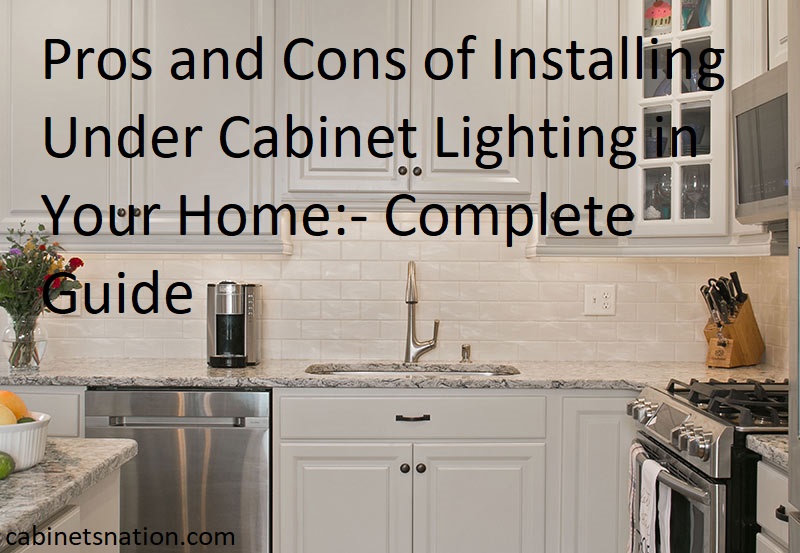Are you looking to spruce up your kitchen? Installing under cabinet lighting can be an easy and low-cost way to do that. From added visibility to creating a cozy ambiance, there are many benefits of using this type of lighting.
Read this guide to get all the information before you make a decision. You’ll find out all the pros and cons of installing under cabinet lighting in your home.
Under cabinet lighting is a useful and attractive feature for any kitchen, offering task lighting in a place where it is particularly needed. Additionally, under cabinets lights can make a space look more modern and aesthetically appealing. This complete guide to installing under cabinet lights will help you decide if this improvement is right for your home, and will provide some tips on how to install it correctly.
When deciding whether or not this type of lighting is right for your kitchen, it’s important to consider both the pros and cons of installing them. On one hand, the cost of installation might be prohibitive and the fixtures can become quite hot to touch when illuminated for extended periods. Additionally, some wiring might need to be run through walls in order to have them function correctly. On the other hand, LED bulbs in these fixtures can be very energy efficient and they provide excellent task lighting while adding style and flair to any space.
Focus on safety should also come into play before making any decisions about this type of installation project; paying attention to important considerations such as cabling specifications for your units will help keep your family safe from electric shock hazards or similar incidents.
Pros of Installing Under Cabinet Lighting in Your Home
Under Cabinet Lighting provides a great way to light up a kitchen, bathroom, and other work surfaces. It is versatile, energy-efficient and can provide an aesthetic look or feel to any space that it is in. Below are some of the benefits to consider when contemplating the installation of Under Cabinet Lighting:
-Versatility: Lights can be installed in many forms and styles, including flush-mounting, hanging swivel, linkable neon lighting strips or fixtures.(Lights can also be recessed into counter surfaces for a custom look). This allows you to customize your space with the perfect light source for whatever function you need it for.
-Energy Efficiency: The small lighting fixtures require very little energy and produce less heat than traditional overhead lights would, leading to significant savings on your electricity bill.
-Cost Effective: Installing Under Cabinet Lighting is very cost efficient compared to other types of lighting solutions. The small fixtures are inexpensive and use minimal amounts of energy while still providing plenty of brightness in any area they are installed in.
-Modern Appeal: Lights installed underneath cabinets give an area a modernized feel with its sleek design —plus, having lights under cabinet adds an element of practicality to any kitchen or workspace as they shine directly onto countertops for easy nighttime use! This adds both beauty and convenience when cooking or prepping food in dark areas.
Enhanced visibility and functionality in the kitchen
Under cabinet lighting can help to make your kitchen a more comfortable and useful space. There are plenty of advantages to installing this type of lighting, including enhanced visibility in the kitchen, increased safety and convenience, lower energy consumption, and improved aesthetics.
Lighting that is installed beneath cabinets can help you to better see food preparation surfaces such as sinks and countertops in addition to providing illumination for tasks such as reading recipes. When it is positioned correctly, the potential for slips and falls can be reduced as there is less need to maneuver around in the dark. With low wattage LED lights running on 110 volts or less; you’ll save energy while still receiving a good amount of illumination. Additionally, strategically placed lights above cabinets can bring a new level of sophistication and style to your kitchen that would not be possible without them.
Improved home ambiance and aesthetics
Installing under cabinet lighting is one way to improve the aesthetics and ambiance in your home. With under cabinet lighting, you can have focused, directed light where you need it the most. This particular type of lighting creates an attractive and softer look that can greatly improve the appearance of any room. It is ideal for task-oriented spaces such as kitchens, bathrooms, and craft spaces.
In addition to being aesthetically pleasing, under cabinet lighting also has practical uses such as providing targeted spot lighting while working at a kitchen countertop or brightening up a room with a warm glow. It’s also energy efficient when compared to traditional overhead lights or lamps. Whether using LED bulbs or halogen bulbs, most are energy-efficient and can be installed without having to worry about high power usage costs.
Cons of Installing Under Cabinet Lighting in Your Home
Before making the decision to install under cabinet lighting in your home, it is important to consider the potential drawbacks. The following are some of the cons of installing this type of lighting in your home:
-Cost: Under cabinet lighting can be expensive, especially if you choose to go with more specialized types of lighting such as LED strips. Additionally, more complex installation processes may require professional help and thus increase the overall cost.
-Electricity Consumption: Many forms of under cabinet lighting consume a lot of electricity, which can increase your energy bills over time. This is particularly true for those lights that do not have energy efficient features such as motion detectors or dimmers.
-Heat Output: Depending on the type of lights used, heat buildup can become an issue and may even require additional ventilation measures. Lights that output significant heat can also cause damage to objects nearby if they are not installed properly.
-Light Quality: Not all types of under cabinet lighting produce uniform light quality throughout their area of coverage. Additionally, some fixtures may create glare on surfaces which can reduce visibility and make tasks more difficult to perform in their vicinity.

Upfront installation costs and ongoing maintenance expenses
Under cabinet lighting is becoming increasingly popular among homeowners, due to its aesthetic appeal and various functional advantages. Depending upon the type of lighting being installed, there may be significant up-front costs associated with the purchase, installation and customization of these fixtures. In addition to these initial expenses, many styles of under cabinet lighting require ongoing maintenance costs for replacement bulbs and accessories as well as regular cleaning if you opt for halogen or xenon bulbs. Therefore, before you make a decision regarding installation, it’s important to consider both the up-front costs as well as any potential maintenance expenses that could arise over time.
When selecting under cabinet lights for your home, the primary choices are LED strip lights, puck lights and halogen / xenon light bulbs. All three options involve similar upfront installation expenses (which vary based on the complexity of the setup) but have varying ongoing maintenance costs over time.
LED strip lights often feature a low up-front cost and minimal ongoing maintenance expenses; however they offer limited customization options in terms of light intensity and may require additional wiring for optimal alignment with your cabinetry design. By contrast, puck lights can provide an extensive range of customizing options but tend to have higher upfront installation fees as well as frequent bulb replacement requirements – which need to be undertaken regularly in order to ensure long-term brightness consistency and even illumination throughout your kitchen or workspace area. Finally halogen or xenon light bulbs usually offer intense brightness combined with extensive customizing possibilities; however they may incur higher initial purchase prices combined with more frequent bulb replacement / cleaning tasks in order to maximize performance longevity over time.
Limited flexibility in design and placement
Under cabinet lighting is a great way to add a stylish and functional look to your kitchen, but one of its drawbacks is the limited flexibility in design and placement. Installing under cabinet lighting involves placing custom-made fixtures in predetermined positions throughout the kitchen walls. This can be more restrictive than other types of lighting, such as overhead lighting, which can be placed anywhere in the room.
Furthermore, under cabinet lighting systems are typically expensive to purchase and install since they may involve custom wiring that must be done by a professional electrician. And once installed, it’s more difficult to rearrange fixtures or move them around if you don’t like the current setup.
Factors to Consider When Deciding Whether to Install Under Cabinet Lighting
When deciding whether to install under cabinet lighting in your home, there are several factors to consider. Some of the most important are:
- Cost: In addition to the price of the lights, you will need to take into account installation costs and any permits you may need from your local municipality
- Light Quality: When selecting a type of light for your under cabinet lighting, research the color temperature and CRI (color rendering index). This will ensure that you receive good-quality light that is natural and comfortable
- Aesthetics: Keep in mind what type of design style you’d prefer; modern and industrial looks often favor cold tones while traditional styles often favour warmer tones
- Safety: When selecting an option for your under cabinet lighting, ensure it’s safe to use with food preparation surfaces or where children play
- Plan Your Layout: Make sure to plan out a layout before making any purchases; this will help you determine how much light is necessary in each area
- Help & Support: Do some research on different brands; find out what kind of customer service they offer as well as any warranties that come with their products
Kitchen size and layout
When considering the installation of under cabinet lighting, it’s important to take into account the size and layout of your kitchen. The amount of lighting, types of lighting sources, and ideal placement for the lights will all depend on how your kitchen is laid out.
For smaller kitchens, it’s best to use edge-lit or clip-on fixtures since they have the smallest footprint, will not interfere with kitchen work surfaces, and can be placed exactly in position. For larger kitchens with an island countertop or breakfast bar area, a more powerful recessed option might be more suitable as this type of lighting will provide more illumination over a wider area.
The number of lights that you need and where exactly you should place them also depends on the shape and size of your kitchen cabinets. If your cabinets are above eight feet tall or are too intricate to be illuminated by recessed fixtures, then surface mounted fixtures may be more suitable in order to provide even light coverage along the length of each cabinet. Additionally, moving around furniture or reducing clutter can help maximize effects from under cabinet lightings as this provides less obstruction for natural light reflection and casting throughout the space.
Personal style and design preferences
When deciding where to install under cabinet lighting, it is important to consider personal style and design preferences. Many people prefer a warm, welcoming atmosphere throughout a kitchen, so installing lights over the counter tops and island can add to that atmosphere. Lights under the cabinets can create an ambient feel in the kitchen space, providing an even light with great task lighting when cooking or prepping food. They also bring out the color and texture of countertops and kitchen cabinets while also making nighttime work more manageable.
On the other hand, bright overhead light is usually preferred in areas where the food will be served such as the dining area or bar area. It casts a wider net of illumination across large spaces while under cabinet lighting often only lights up specific surfaces instead. Too-bright lights can be too harsh on kitchen fixtures and appliances like sinks and ovens, causing them to appear dull in their cast metal finishings.
Consideration should also be given to power consumption when choosing between overhead lights vs under cabinet lights; LED bulbs are typically used for undercabinet lighting since they use less power than halogen or incandescent fixtures.

Budget and long-term cost considerations
Under cabinet lights can vary greatly in cost, depending on the type of lighting chosen. A budget-friendly option to consider is LED strips and bars, which are available in a wide range of colors and provide significant brightness levels at relatively low cost. For a more substantial upfront cost, halogen and xenon lights offer greater brightness and customizable options while incandescent lamps may be the least costly to purchase but will generally increase your energy costs in the long-term due to their higher wattage consumption.
No matter which type of lighting you choose, professional installation is usually recommended as there may be extra wiring or electrical components required based on the size, shape and design of your under-cabinet area. If you do elect to do the work yourself you should ensure that any additional equipment is rated for damp/wet locations (especially for use in kitchens) and that it’s UL approved for safety reasons. In addition, you should take into consideration the projected lifespan of each fixture as well as their expected energy consumption over time to calculate a complete budget after installation.
Conclusion
Overall, under cabinet lighting is a great addition to any home as it can provide great function, increased safety, and improved ambiance. Installing the lights can be a DIY project for those who are handy with tools, or you can contact a professional for installation. The main step will be selecting the right type of light for your cabinet size and available power supply.
If you’re considering incorporating under cabinet lighting into your home, there’s no time like the present to make the upgrade. With so many options available and relatively low costs associated with the installation of quality lights, it won’t be long before you reap the rewards of this popular home improvement project.
FAQ’s
What are the disadvantages of under cabinet lighting?
The main disadvantage of under cabinet lighting is that it can increase heat in the cabinet and affect the items stored in it. Additionally, it can be difficult to clean and maintain fixtures and can be costly to install.
Is it worth getting under cabinet lighting?
Yes, it is worth getting under cabinet lighting. Under cabinet lighting can provide added ambience to your kitchen or workspace. It can make a room seem more inviting and comfortable to be in. Additionally, under cabinet lighting can make it easier to work on countertops and other tasks in the kitchen, making it a safer and more enjoyable experience.
Do under cabinet lights use a lot of electricity?
No, under cabinet lights usually use very low wattage LED bulbs and typically use little electricity.
Do under cabinet lights get hot?
No, under cabinet lights typically do not get hot. Generally they are cool to the touch.
How long does under cabinet lighting last?
Under cabinet lighting typically has a lifespan of 25,000 to 50,000 hours, depending on the type of lighting used.
Where is the best location for under cabinet lighting?
The best location for under cabinet lighting is usually along the underside of upper cabinets, slightly in front of and centred on the items being lit.
What type of under-cabinet lighting is best?
The best type of under-cabinet lighting is LED strip lights as they are energy-efficient, long-lasting, and provide a range of illuminated colors.
What type of cabinet lighting is best?
The answer depends on the type of lighting desired, budget and overall design. Generally, LED under-cabinet lighting is the best choice because of its durability and longevity. Additionally, recessed lighting and pendant lights can provide a more stylish, modern look.
Which is a disadvantage of kitchen cabinet?
A disadvantage of kitchen cabinets is their limited storage space. Depending on the size of the kitchen and the type of cabinet chosen, there is often insufficient room to store items such as plates, pots and pans, utensils, and other kitchen items. Additionally, kitchen cabinet installation may require a significant investment in terms of both time and money.
What is the typical cost for under cabinet lighting?
The typical cost for under cabinet lighting is between $30 and $100 per fixture.
See more-
- Best cabinet doors 2023
- Best guitar cabinet 2023
- Best cabinet primer 2023
- Best 2×12 guitar cabinet 2023
- Best kitchen pantry cabinet 2023


